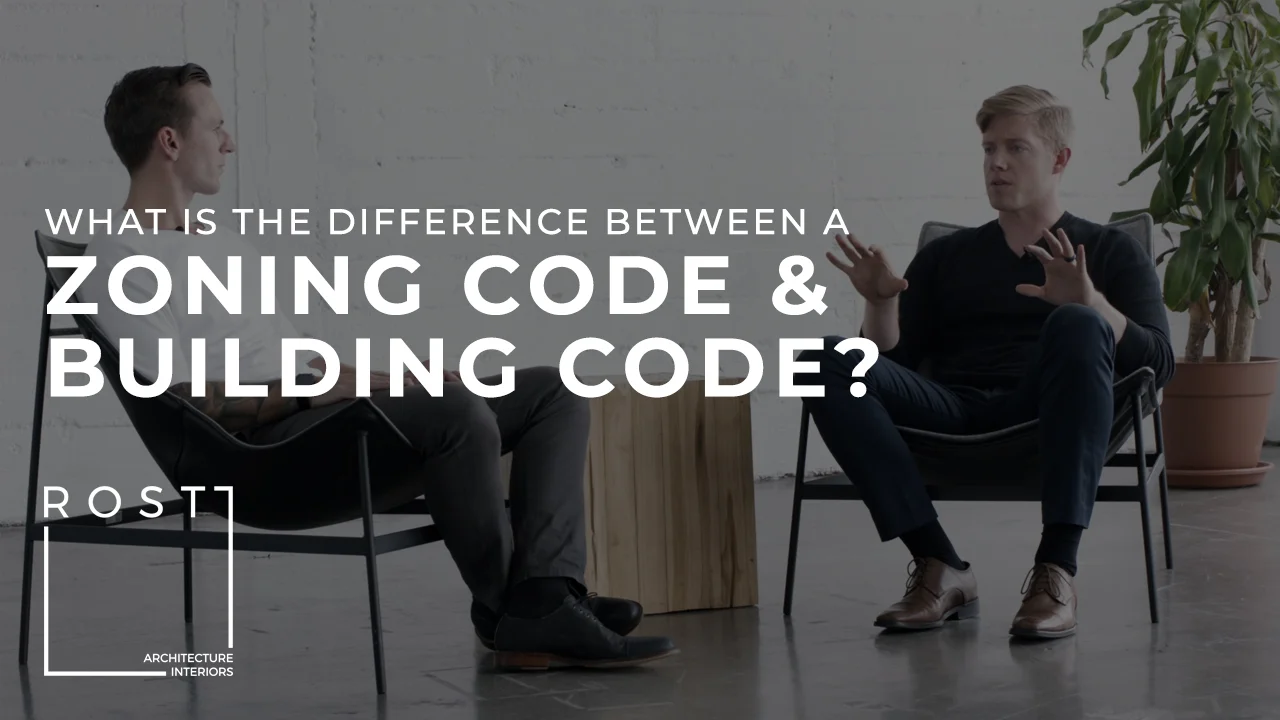WHAT IS THE DIFFERENCE BETWEEN THE ZONING CODE AND THE BUILDING CODE?

We get this question often from clients. The Zoning Code and the Building Code are the two main codes that a project must comply with. Below is a quick description of each and how they differ from each other. To watch our video on the difference between the building code and the zoning code, click here.
ZONING CODE:
A project typically moves through the Zoning Department first. In the Zoning Department, the project will be reviewed to be sure it is conforming to the local Zoning Code. This phase is often referred to as the entitlements phase.
A Zoning Ordinance is the local law that regulates the immediate, allowable use of each piece of land within a city or county. Each city or county will have its own unique zoning code. For example, the zoning code in Santa Barbara is going to be different from the Zoning Code in Newport Beach. The reason for this is the code must address the local conditions of each area. Each zoning code is typically made of of two parts, a text which sets forth a written description of the property development standards and an illustrated map which graphically depicts the different zones within the city or county.
A Zoning Ordinance assigns each parcel within the city or county a set of regulations which govern the type of building allowed to be developed on a SPECIFIC piece of property and how a building can interact with the piece of land. For example, typical zoning regulations are building height, setbacks from the property lines, open space requirements, parking requirements, and maximum floor area ratios for the building. Zoning requirements are often addressed in the beginning phases of the project.
It is important to note that in many coastal communities, it is common to see an additional set of guidelines that a project needs to conform with. These are typically called Design Guidelines. These are often a more detailed set of regulations which deal more with the aesthetic character of the structure and project specific assessments. For example, in the city of Laguna Beach, projects must conform with a set of Design Guidelines and are subject to a process called Design Review. To read more about the Design Review process, click here to check out our article on the "Seven Steps For Getting a Permit to Build Your Custom Home in Laguna Beach."
BUILDING CODE:
The Building Code deals with safety and technical related requirements such as fire safety requirements, structural loads, maximum occupancy loads, mechanical/electrical/plumbing requirements just to name a few. Unlike the Zoning Code which is unique for each city or county, the Building Code is a state wide code which all structures in the state of California must conform with. The building code in California is called the CBC or California Building Code.
In some instances, there may be some overlap in requirements between the Building Code and the Zoning Code. A classic example of this is the height restriction. Typically a zoning code will have a maximum allowable height that your building must be under and the CBC also has a section which regulates the maximum height of a building for fire safety. A good rule of thumb to use when in a situation like this is that the most restrictive requirement will apply.
When selecting an Architect for a project, it is advisable to work with a firm who has experience in the jurisdiction. If they are working on projects in the area, they should have good handle on the local zoning code regulations and process at the city. Each city or county has its own quirks and nuanced requirements. A firm who has experience in the area will be able navigate the permitting process more efficiently thus saving valuable time and resources for the project schedule and budget. If you need guidance getting your project approved through the different jurisdictions where your project is located. Feel free to contact us by clicking here.
Thinking about designing and building a custom home? To successfully complete your project, many different people will need to be involved and bring their individual expertise to the table. The quality of your project team will largely determine the outcome of your home.
Should you build your home from metal studs? What are the positives and negatives of metal stud construction? Over the past few years, we’ve had more and more clients ask about building their custom home from metal studs. Read the article to hear our un-biased opinions on the positives and negatives of metal stud construction.
Learn our five tips for building a custom home. These can save you time, money and headache during your project.
Selecting the right Architecture firm for your residential project can be difficult. Depending on the project, it can often mean entering into a 1-3 year relationship. During this time there will be challenges and hurdles to overcome. You will be working closely with your project team therefore, it is critical that you can communicate effectively and your personalities are compatible.
In our custom homes, the kitchen counter material is often one of the first selections made in the finish pallet. Kitchen surfaces are usually focal points in our designs and set the tones, textures and feeling for the rest of the materials in the space. The surfaces are used and engaged with daily, therefore it is critical to get the material selection right in terms of aesthetics and functionality. The article outlines some of the most common materials we use for kitchen counter tops and the pros/cons of each material.
An air tight, highly insulated building envelope is one of the most effective methods for helping to reduce your homes energy consumption and lower your carbon footprint. Therefore, the type of insulation you decide to use in your home is critical. Learn about the different types of insulation and the pros/cons of each type.
Home Battery technology has been steadily improving over the past few years but has it advanced enough? Learn about the current state of the technology and if it makes sense for your home.
Do you want to build a custom home? Learn about the major milestones in the construction process. This article gives a general breakdown of the process for homeowners.
What do the fields of wellness and architecture have in common? Wellness is becoming a daily active pursuit for many. With all the buzz around the topic, one thing we don’t hear about much is how the buildings and spaces we inhabit daily, impact our well being over time.
Learn why you should build your home net zero energy. Buildings account for nearly 40 percent of our total energy consumption and CO2 production. By reducing the energy your home uses, you will be helping to reduce our overall carbon footprint.
Learn our top six reasons why you should install a green roof on your net zero home.
Learn the fundamentals for sizing your solar panel system based on your energy usage and location.
One of the fundamentals for designing a sustainable home is to create a well insulated and air tight envelope. Learn about Insulated Concrete Forms and how they can help create a more sustainable and resilient building.
Learn about how many of the coastal communities in Southern California administer the design review process. For more information on the design review process, specifically in Laguna Beach, check out our article at https://www.rostarchitects.com/articles/2018/4/20/five-things-you-need-to-know-about-building-a-house-laguna-beach
Learn three fundamental ways to design a low carbon footprint home. Rost Architects uses their Villa A prototype to illustrate the concepts.
Rost Architects explains seven things you should look for when buying land to build your custom home. To learn more, check out the article here.
Learn why it is important to understand the “General Conditions” in the contract for construction when building your custom home.
Check out the latest article from our interiors group describing six strategies we use to create minimal interiors in our projects.
After the recent fires in Northern and Southern California the reality of wildfires and their level of potential destruction is more evident than ever. Learn seven methods we implement in our projects to design fire resistive homes.
Watch Rost Architects interview on building along the California Coast and dealing with the California Coastal Commission.
Watch Rost Architects interview about how we begin the design process using site and context.
Watch Rost Architects interview where we discuss the difference between the building code and the zoning code. Understanding the difference is important for home owners during the design and permitting process.
Watch Rost Architects interview where we discuss the importance for a real estate development team to have an architect and broker on board.
Are you searching for a property in Newport Beach to build your dream home on? If so, having a general understanding of the zoning requirements is essential in selecting the perfect lot.
What is the California Coastal Act and how do I know if my project will need a Coastal Development Permit?
The Zoning Code and the Building Code are the two main codes that a project must comply with. This article gives a brief description of each code and why it is important to understand them both.
Building a home in Laguna Beach may not be the simplest process, however achieving the final goal of establishing residency in the community can be an incredibly rewarding experience.






























